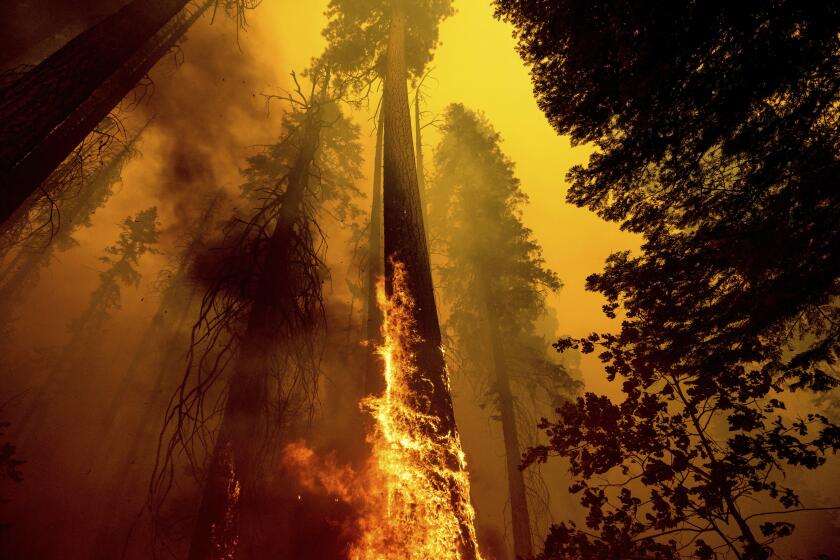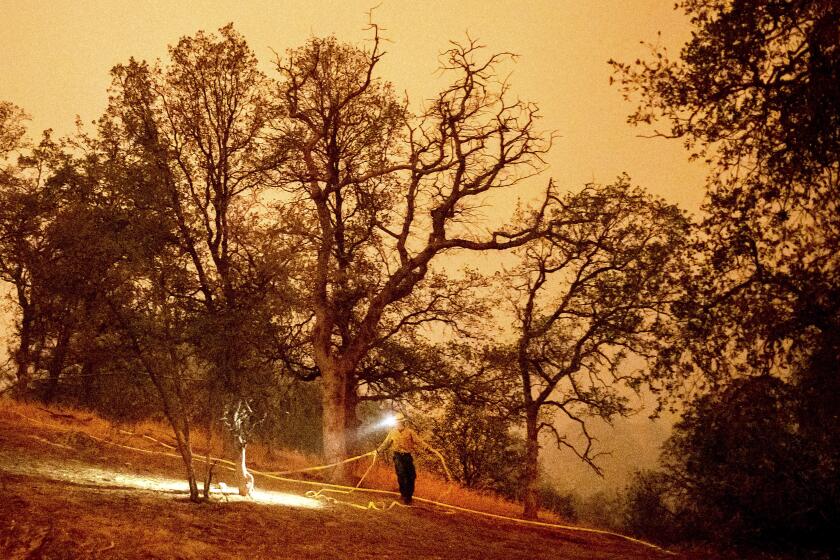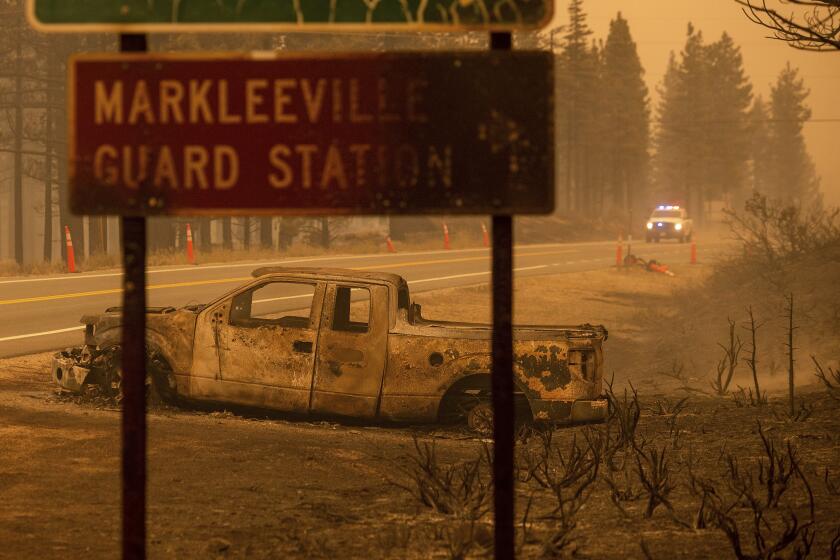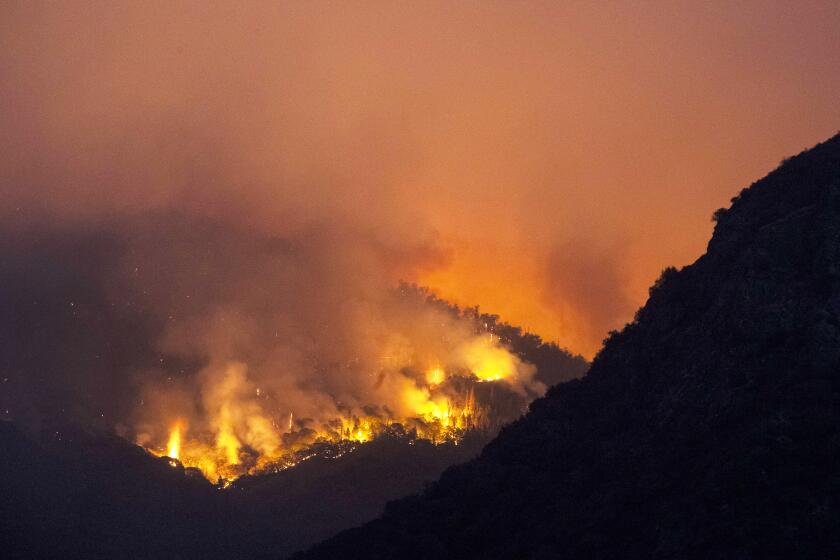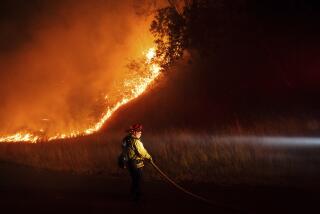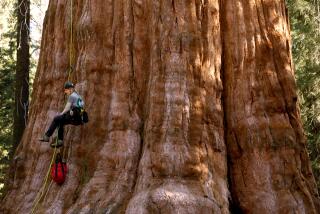Fighting fire with fire: How prescribed burns could help save the world’s largest trees
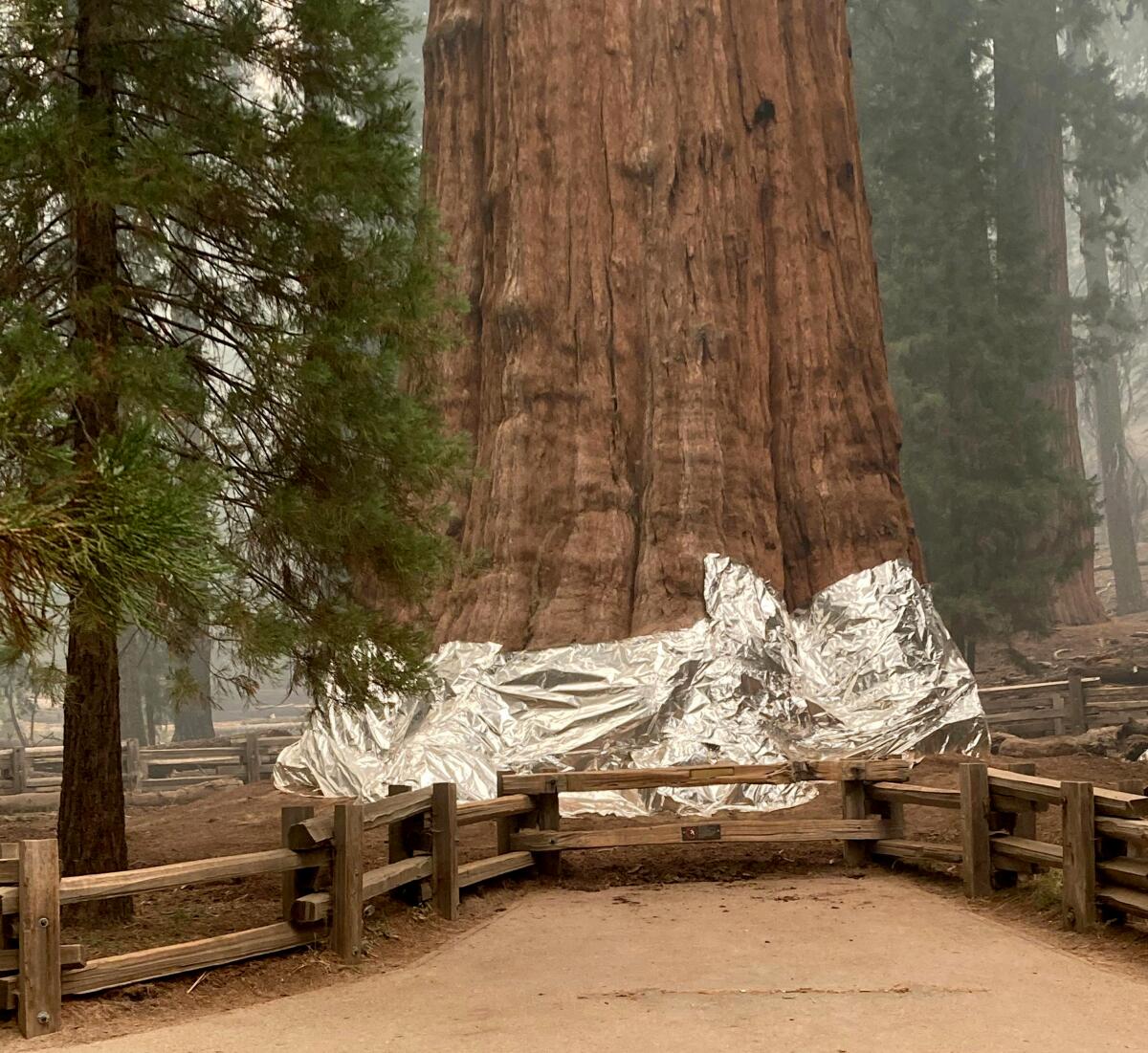
As the growing KNP Complex fire creeps toward California’s ancient groves of sequoia trees, firefighters are hoping a delicate and specialized tool will help protect the beloved behemoths: more fire.
Experts say prescribed burns, also known as controlled burns, are becoming increasingly important as California faces a new breed of hotter, faster and more frequent wildfires. The intentional use of fire on the landscape can help clear away dried vegetation that enables blazes to quickly get out of control.
Officials are now banking on the strategic use of fire, as well as a history of prescribed burns in Sequoia National Park, to help keep destructive flames from reaching the towering trees. Last year, an estimated 10% of the world’s sequoias were lost in the Castle fire, and no one wants a repeat performance.
Photos of the Windy fire near the Tule River Reservation in the Sequoia National Forest as crews from the Sierra Cobras and Roosevelt Hotshots fight it.
There’s “a lot of really methodical work going on in this area to protect those giant trees,” said KNP Complex operations section chief Jon Wallace.
As of Friday, the fire had swelled to 11,365 acres with no containment, officials said. It was within striking distance of the Giant Forest, home to General Sherman, known as the largest tree on Earth, and thousands of other sequoias. The 6,800-acre Windy fire, burning farther south than the KNP Complex, has already crept into a grove of the trees.
The practice of prescribed burns is not new. For centuries, many of California’s indigenous communities considered it essential for forest health and employed it to great success, said Don Hankins, a professor of geography at Cal State Chico and a person of Miwok descent.
But the method is not without pushback. Many residents do not like fires — even intentional ones — in their backyards, and public officials face the potentially career-ending risk of a prescribed burn getting out of control. Already this year, the notion of allowing fire to play out across the state’s landscape came under intense scrutiny when the Tamarack fire burned beyond expectations.
Yet with climate change fanning increasingly extreme wildfires, prescribed burns may be the best tool California has in its arsenal, Hankins said, not just for the health of the forest but also for the people losing their homes to wildfires and suffering from the smoke they produce.
The 8,940-acre KNP Complex fire is within striking distance of Sequoia National Park’s Giant Forest, home to the largest tree on Earth, officials said.
With prescribed burns, “you can select the time when it’s going to happen, you can have greater control over what the outcomes of those fires are going to be, and then change the shape and the way that future fires will interact within that landscape,” Hankins said. “With wildfires, we don’t really have a choice of what those impacts are.”
Crews on Friday were hoping that the Giant Forest’s history of prescribed burns, dating back to the late 1960s, would keep the flames from entering the area. They also were prepared to put even more fire on the forest floor if necessary — effectively fighting fire with fire.
“We’re going to go in there and start basically burning out underneath those trees to protect them,” Wallace, the operations section chief, said during a Thursday evening update. “Probably going really slow — maybe as slow as one tree at a time — burning a circle underneath that tree and then moving onto the next one.”
Defensive burns aren’t the only tactic for defending the Giant Forest against the burgeoning blaze, officials said. Crews with the California Department of Forestry and Fire Protection have been using hand tools and bulldozers to create containment lines, which can help slow the spread of flames.
Crews this week also wrapped the base of some trees in protective foil, a striking image in a fire-addled state.
Wallace said Friday that controlled burns in Giant Forest would be implemented if all other lines of defense fail. With so much unpredictability in a wildfire, including wind and topography, burn operations are a highly effective means for regaining some control.
“It puts fire on the landscape in a lower intensity,” KNP Complex incident spokeswoman Katy Hooper said. “It cleans out that debris and litter, so if a fire then does come into an area, there’s no more fuels to be able to help.”
It’s the reason that crews battling the recent Caldor fire near South Lake Tahoe considered “steering” that fire into the nearby burn scar of the Tamarack fire, where the complete dearth of vegetation would effectively stop the spread of flames.
And although wildfire has long been understood as an ecological fact of life in California, fire scientists and ecologists say prescribed burns are increasingly needed to replicate a natural process that no longer is regularly occurring.
As California has grown more populous, officials have suppressed more and more fires in a necessary effort to protect people, homes and infrastructure. The U.S. Forest Service employed a “10 a.m. rule” through the 1970s, which prompted crews to put out every wildfire by 10 in the morning after a blaze ignited.
The U.S. Forest Service indicates it will be more aggressive in putting out blazes early rather than letting some burn as a way to thin out brush.
That had disastrous effects on the landscape, multiple experts say, as more than a century of suppressing fires has created a surplus of overgrowth and understory in the state’s forests. The West’s recent record-breaking heat and worsening drought have dried much of that surplus vegetation, creating a recipe for really hot, really fast and potentially destructive fires.
“In the past, fires burned through sequoia groves sort of like clockwork,” said Nate Stephenson, a research ecologist with the U.S. Geological Survey, noting that some big groves might have seen fires every five or 10 years.
“It kept the fuels down, the dead material down, and kept the forest thinner,” he added. “That’s how it used to work. But then we had a long period of fire suppression.”
Sequoias are also adapted to fire, Stephenson said, and, in fact, depend on it for reproduction because fire helps release their seeds.
And while historical tree ring records have indicated some high-intensity fires reached the sequoias in the past — including a “benchmark fire” that happened in the year 1297 — few trees are armored against the conditions the state faces today. As the KNP Complex marches deeper into the drought-dried forest, that preemptive burn work will be more important than ever to aid in the trees’ defense.
“I think everything we’ve seen over the last two summers surpasses that,” Stephenson said of the landmark 13th century blaze.
Flames from the KNP Complex fire could soon reach the sequoias in the Giant Forest, fire crews warn.
Earlier this month, the California Legislature approved a bill that would expand the state’s use of prescribed burning to control combustible fuels, as well as limit the liability for crews who ignite them under specified conditions. It is awaiting approval from Gov. Gavin Newsom, but if passed, it could be an important step for achieving fire resilience in the state, scientists said.
“If we don’t get on it, and we don’t start scaling fire to the landscape and really changing the future, then we have a huge potential to lose all the things that we really care about in the forest, and in the landscape in general,” said Hankins, the Chico professor.
Many watching the KNP Complex’s progression said they feel confident that the Giant Forest will make it through relatively unscathed, given that the popular tourist area has been highly managed and subjected to one of the oldest prescribed fire regimes on the West Coast.
Others noted that the fire could even be beneficial for the area, so long as it plays along the forest floor and doesn’t climb up to the trees’ crowns. Some of the sequoias’ lowest branches are more than 100 feet high.
But there are other groves — steeper, more remote areas — in the path of the wildfire that have received less attention. The Windy fire burned into the Peyrone grove this week, officials said, but inaccessible terrain has so far prevented crews from assessing damage to the trees. Their future is far less certain, and as the Castle fire proved last year, the destruction of sequoias is not without precedent.
“I’m optimistic about Giant Forest, but there are some other groves that might suffer more,” Stephenson said. “Some have had prescribed fire, and some have not. If it’s been decades since they had one, that’s enough time for fuels to build up again.”
Times staff writer Lila Seidman contributed to this report.
More to Read
Sign up for Essential California
The most important California stories and recommendations in your inbox every morning.
You may occasionally receive promotional content from the Los Angeles Times.
